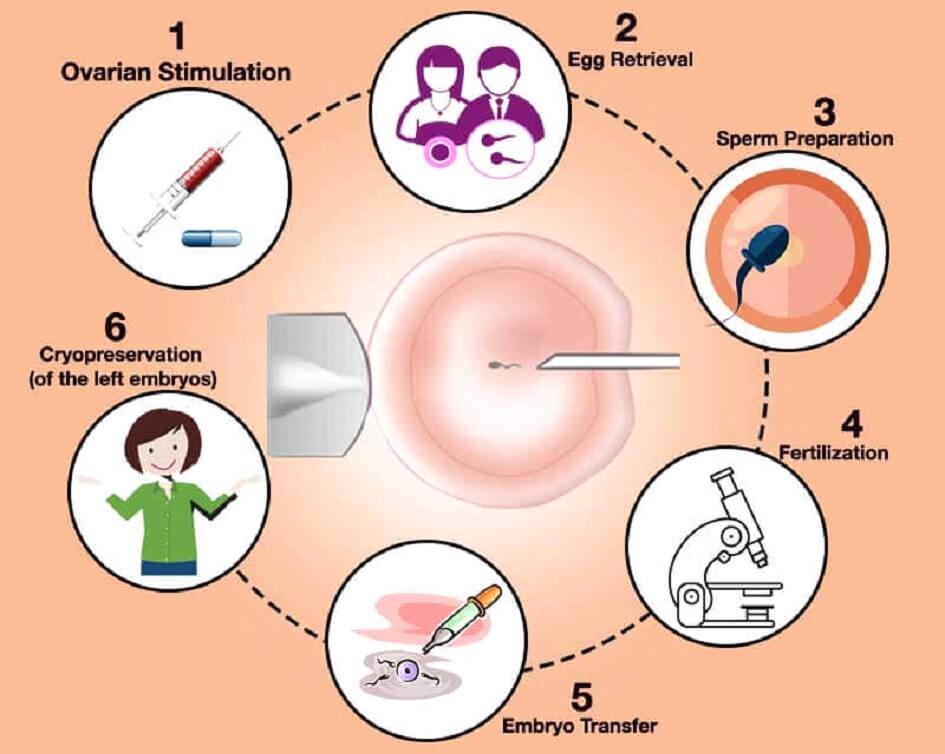
Intracytoplasmic sperm injection (ICSI) can be used as part of an in vitro fertilization (IVF) technique to help you conceive. ICSI is the most successful form of treatment for male infertility and is used in nearly half of all infertility treatments. ICSI takes one sperm, which is injected directly into the cytoplasm of the oocyte (egg). The fertilized egg (embryo) is then transferred to your uterus (womb).
Shown in the image is the ICSI (Intra cytoplasmic sperm injection) process in which one sperm is being injected in one oocyte (egg) for fertilization. ICSI is the treatment of choice for male factor infertility. Cases in which the sperm count is low or the sperm motility is less , which means that the sperm is either unable to reach the egg or to enter the egg. This can be assisted by the help of ICSI.
Numerous couples conceive with the help of ICSI. This is one of the most advanced techniques. ICSI got a revolutionized infertility treatments and got us closest to fertilization. In ICSI forced fertilization , which is inserting the sperm directly in the egg with an injection pipette.
MALE INFERTILITY INCLUDES
- Aspermia – complete lack of semen
- Asthenozoospermia – reduced sperm mobility
- Azoospermia – absence of sperm cells in semen
- Hyperspermia – large semen volume
- Hypospermia – small semen volume
- Oligozoospermia – few spermatozoa in semen
- Necrozoospermia – dead or immobile sperms
- Teratozoospermia – sperm with abnormal morphology
WHO criteria for normal semen
| Year | WHO 1999 | WHO 2010 |
|---|---|---|
| Volume | 2 ml | 1.5 ml |
| Concentration | 20 million/ml | 15 million/ml |
| Low Normal Range | 50% | 32% |
| Normal forms | 14% | 4% |
For all male factor infertility, ICSI is the ultimate solution. In case of men with no sperms in the ejacuate but sperms present in the testis (obstructive azoospermia ), a testicular sample is taken, sperms are extracted and ICSI is performed.
What are the potential risks associated with ICSI-IVF?
For the egg:
As ICSI is more invasive and requires more handling than standard IVF insemination techniques, there is a small chance (less than 2%) that the egg may be damaged during the procedure – resulting in a non-viable egg.
For the resulting child:
Thousands of children around the world have been born as a result of ICSI. So far, there is no convincing evidence that the incidence of birth defects is any different with ICSI or IVF compared with children born to other parents of similar age and health.
The mother’s age at delivery, family history and the presence of pregnancy complications are the most important predictors of newborn health. However, it is possible that a male child born as a result of ICSI might have a fertility problem similar to his father’s.
Other factors to keep in mind
Some men have an acquired cause of their sperm problem that we know will not be hereditary (such as a vasectomy or spinal cord injury). However, other men have sperm problems that may have been present since birth. These may be passed on to the male children due to a small chromosomal rearrangement or a deletion of a small portion of the Y chromosome. Also, men with very low sperm counts or an obstruction in their sperm ducts (vas or epididymis) may carry one of the cystic fibrosis (CF) genes. In this situation, the child may inherit the CF gene and if the female partner also carries one of these genes, there is a chance of producing a child who actually has CF.
Just as the mother’s age influences the risk of birth defects, men with very low sperm counts also have an increased risk of producing a son with an abnormal number of sex chromosomes (XXY or XYY instead of the usual XY). These children have a normal physical appearance and are likely to have normal IQs, but they may develop learning difficulties, behavioural problems or infertility.
Blood tests can screen one or both partners for many (but not all) of these problems, including chromosomal rearrangements and CF carrier status. Genetic testing (amniocentesis or chorionic villus sampling) is also available during the pregnancy to look for many of these abnormalities.

